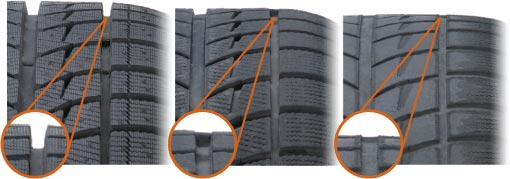
If you frequently drive on wet roads consider replacing your tires. Low tread depth on car tires can be a factor when it comes to hydroplaning so whats a quick way to check your tread.

Consider these variable stopping distances on wet roads according to tire tread depth.
How much tread should be on a tire. Your tires tread depth is sufficient. If snow-covered roads are a concern you should consider replacing your tires. If you frequently drive on wet roads consider replacing your tires.
Its time to start shopping for new tires. They are close to being worn out. Interpreting tire tread depth as it relates to traction and safety.
Keep in mind that even if your tires have more than the minimum 232 of tread depth remaining or even 432 thats not reason to put your tire situation to back of mind and move on. Tire tread depth is critical to driving safety in a variety of road conditions. Consider these variable stopping distances on wet roads according to tire tread depth.
The typical new tire used on automobiles is measured with 1032 to 1132 of tread depth. With wintersnow and light truck tires the tread is deeper because this depends on the tires tread type which is either the Highway Rib Highway All-Season Off-Road All-Terrain or Off-Road Maximum Traction. You should monitor your tire tread depth closely once it reaches 432 inch deep.
If you want to check it yourself heres how to assess your tread depth. The Penny Tire Test There are several popular ways to check your tire tread depth. For tire geeks a half-tread depth tire has typically 532- to 632-inch of tread depth remaining.
Tires are worn-out when they reach 232-inch but as the chart below shows you dont need to go. Tire tread depth in the US. Is measured in 32nds of an inch and several states require you to replace them when depth falls to 232.
Department of Transportation also recommends replacing your tires when they diminish to that depth. New tires on average start with 1032 to 1132 of original tread depth. For summer tires the remaining tread depth must be no less than 3 mm and for winter and all-season tires it must be no less than 4 mm.
Smaller tread depth may become critical on wet pavement slush or snow. New tires typically come with 1032 or 1132 tread depths and some truck SUV and winter tires may have deeper tread depths than other models. Department of Transportation recommends replacing tires when they reach 232 and many states legally require tires to be replaced at this depth.
Tires in good condition should have a minimum of 632 to be useful or 432 if the tire is 13-14. The average legal minimum tread depth is 232 but driving becomes unsafe with such a tread. Besides most dealerships require at least 432 tread to trade-in a car without prior a tire change.
How to measure your tire tread depth with a gauge. Find the shallowest groove of the tread and insert the pin of the gauge until the base is flush with the tire. Heres what you might see and what you should do.
632 Your tires tread depth is sufficient. Tire Racks advice is that if rain and wet roads are a concern you should consider replacing your tires when they reach approximately 432 of remaining tread depth A typical passenger car tire has about twenty square inches of total footprint surface and begins with about 13 of tread depth. How to check your tire tread depth.
Updated February 1 2021 931 PM. Low tread depth on car tires can be a factor when it comes to hydroplaning so whats a quick way to check your tread. Originally published February 1 2021 923 PM.
For example a typical tire that starts with 1032 of original tread depth has only 832 of useable tread depth. Its useable tread depth is calculated by subtracting a worn out tires 232 from the new tires original depth of 1032. The final 232 of a tires tread depth.
If the top of his head is flush with the tread you have about 432 inch of tread left meaning you have some grip remaining for rainy or snowy conditions. According to the tire industry the average tread depth of a new tire can range from 1032 to 1132. 7 Tires age whether they are driven on or notbe sure to check tires on recreation vehicles trailers collector cars community vehicles and 15-passenger vans too.
Tread depth so they can bite into the snow. Most winter tires start at 1032 to 1232 of tread depth. 632 is the minimum tread depth that we recommend for winter driving.
Its important to do more than just a quick visual check of your tires tread depth. While a tread. Per code section 39375 c tires shall have a tread groove pattern depth of at least 232 of an inch when measured in a major tread groove It also states that measurements cant be taken where tie bars humps or fillets are located DOT steer tire regulations state that depth is at least 432 of an inch.
In most parts of the world tires are considered to be legally worn out when they reach 232 approximately 16mm of remaining tread depth. Law requires tires to have easy-to-see Tread Wear Indicator bars running from one side of their tread design to the other when the tires tread has worn down to the minimum legal limit of 232 inch.